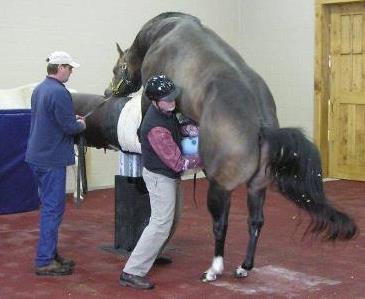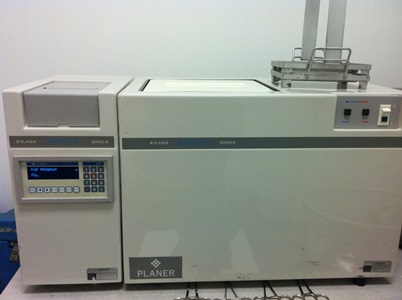 It is generally known that the quality of semen after freezing is dependent upon how good the semen is immediately after collection and prior to freezing. In some cases there is nothing one can do to improve the quality of the semen collected and one has to deal with the cards he has been given. However, there have been several management factors identified that adversely affect the quality of semen collected. The goal of every collector should be to carefully prepare the AV and collect the stallion on one mount. Each time a stallion mounts and enters the AV and does not ejaculate the pre-sperm is accumulated in the bottle. After each unsuccessful collection attempt the bottle should be replaced with a warm fresh bottle. If this does not occur we know that the quality of the semen will be decreased.
It is generally known that the quality of semen after freezing is dependent upon how good the semen is immediately after collection and prior to freezing. In some cases there is nothing one can do to improve the quality of the semen collected and one has to deal with the cards he has been given. However, there have been several management factors identified that adversely affect the quality of semen collected. The goal of every collector should be to carefully prepare the AV and collect the stallion on one mount. Each time a stallion mounts and enters the AV and does not ejaculate the pre-sperm is accumulated in the bottle. After each unsuccessful collection attempt the bottle should be replaced with a warm fresh bottle. If this does not occur we know that the quality of the semen will be decreased.
Preparation of the AV is extremely important. The water temperature placed in the AV should be monitored and the final temperature of the AV prior to collection should be in the 46-50 degree Celsius range. It is not enough to use one’s hand to feel the AV and say that it is OK but the temperature should be determined by a thermometer that has been calibrated and known to be correct. If an AV is too hot then the sperm can be damaged. Also the stallion may be reluctant to breed a hot AV or if he does and it burns him then he may be reluctant to breed again. However, it is more likely the AV temperature is too low because the hot water tank is not turned up high enough. If this is the case then the stallion will not work the AV and may not ejaculate on the first mount or even after several mounts.
The skill of the collector can also affect how quickly the ejaculate is collected and how many mounts are required. Holding the AV at the wrong angle can disturb the stallion and prevent him from ejaculating. Failing to drain the water out of the AV immediately after collection can trap the sperm in the hot part of the AV and damage the motility and morphology of the sperm. It may also cause latent damage. This is where the damage is not seen immediately but shows up after storage of the sperm such as with cooled semen.
 The amount of lubricant that is used to prepare the AV is extremely important. One common mistake is the technician uses a whole hand full of lubricant. This results in the lubricant being driven into the semen by the stallion’s penis and the sperm are severely damaged by the high osmotic pressure of the lubricant. One should use only a small amount to lubricate the front part of the AV.
The amount of lubricant that is used to prepare the AV is extremely important. One common mistake is the technician uses a whole hand full of lubricant. This results in the lubricant being driven into the semen by the stallion’s penis and the sperm are severely damaged by the high osmotic pressure of the lubricant. One should use only a small amount to lubricate the front part of the AV.
In collaboration with the Gluck Center at the University of Kentucky we examined data from stallions collected by SBS in Maryland and Texas to see what effect multiple mounts prior to ejaculation had on the initial semen after collection and what effect multiple mounts had on the quality of the semen after freezing. We also asked what is the relationship between the initial concentration after collection and the quality of semen after freezing and thawing. Our thought being that the higher the concentration, the better the post-thaw motility.
Semen collection and freezing records were available from 761 stallions and a total of 12,397 ejaculates over the time period of 1996-2012. The criteria was that at least 3 ejaculates were obtained from each horse and that the sperm motility was evaluated objectively with computer assisted sperm motion analysis (CASA) and semen were frozen with a programmable cell freezer. Measurements included total motility, progressive motility, and concentration of sperm upon collection, gel-free semen volume and the total number of sperm in the ejaculate.
Although the number of mounts per ejaculate ranged from 1 to 8, the number of horses that took more than 4 mounts to ejaculate was small and data from these stallions were not included in the analysis. The volume of the gel-free portion of the ejaculate increased as additional mounts were required for ejaculation even though the bottle was changed each time between attempts to collect semen. The extra mounts required for stallions to ejaculate also resulted in a decrease in concentration of semen and a decrease in progressive motility. This is certainly not what you want if you are trying to ship cooled semen or freeze semen. Much to our surprise the total sperm in the ejaculate was greater when extra mounts were required to collect the stallion.
 A second objective of this study was to determine the relationship between the initial concentration of the sperm upon collection and the post thaw motility. We found that there was a positive correlation between initial concentration of the sperm and post thaw total and progressive motility. Meaning that the higher the initial concentration the better the post thaw motility. This is all the more reason to collect the stallion on the first mount so the concentration of the sperm remains high.
A second objective of this study was to determine the relationship between the initial concentration of the sperm upon collection and the post thaw motility. We found that there was a positive correlation between initial concentration of the sperm and post thaw total and progressive motility. Meaning that the higher the initial concentration the better the post thaw motility. This is all the more reason to collect the stallion on the first mount so the concentration of the sperm remains high.
This information was selected to be presented orally at the 11th International Symposium on Equine Reproduction in Hamilton New Zealand on January 26-Feb 1, 2014. The senior author on the paper was a student, Julie Kalmar, who is working on a MS degree at the University of Kentucky.
Being able to access the data from Select Breeders Service was extremely valuable since nowhere else is one able to include that many stallions and ejaculates in a trial. Most of the information on stallions presented at this meeting was based on only a few research stallions in each study. Additional reports will be coming out of this study including some very important information on the effect of season and age on the freezability of stallion semen and the difference in freezability of semen from more than 10 different breeds.


Log in to join the conversation.